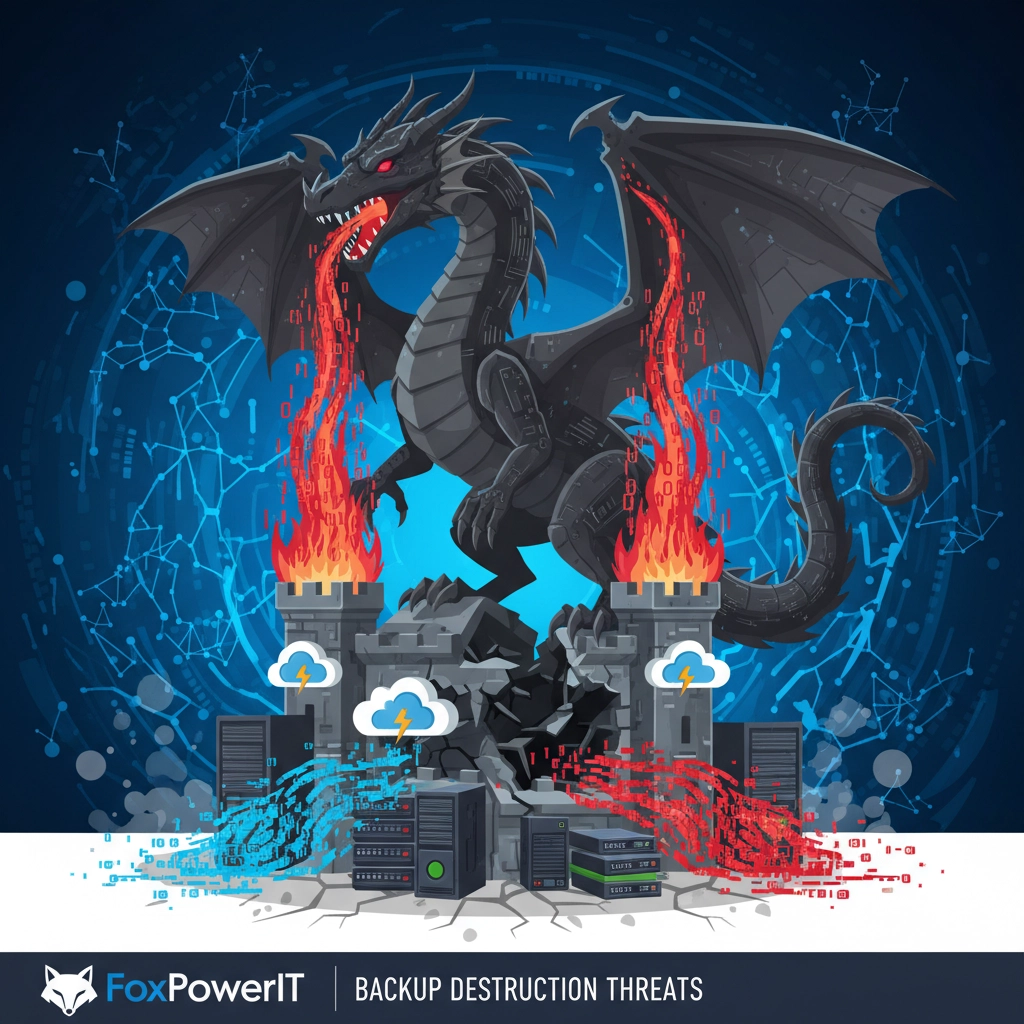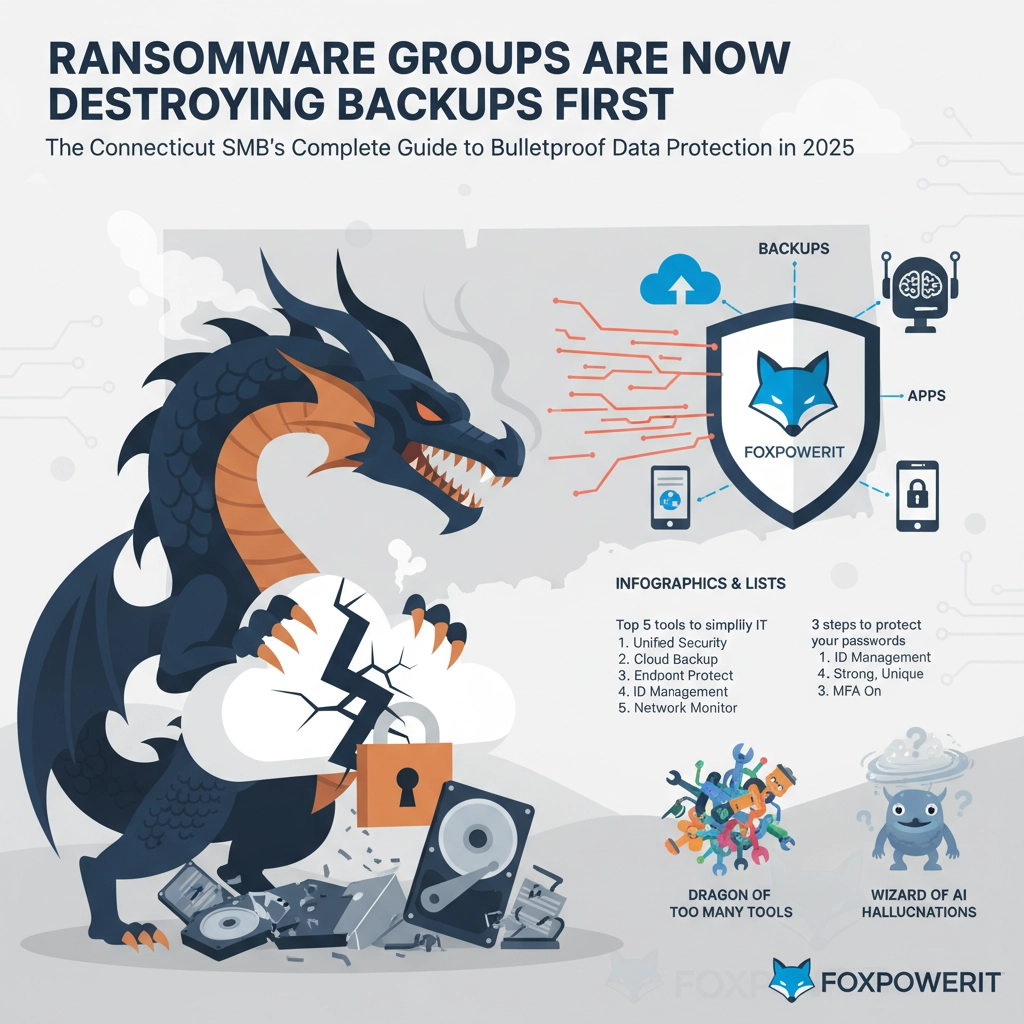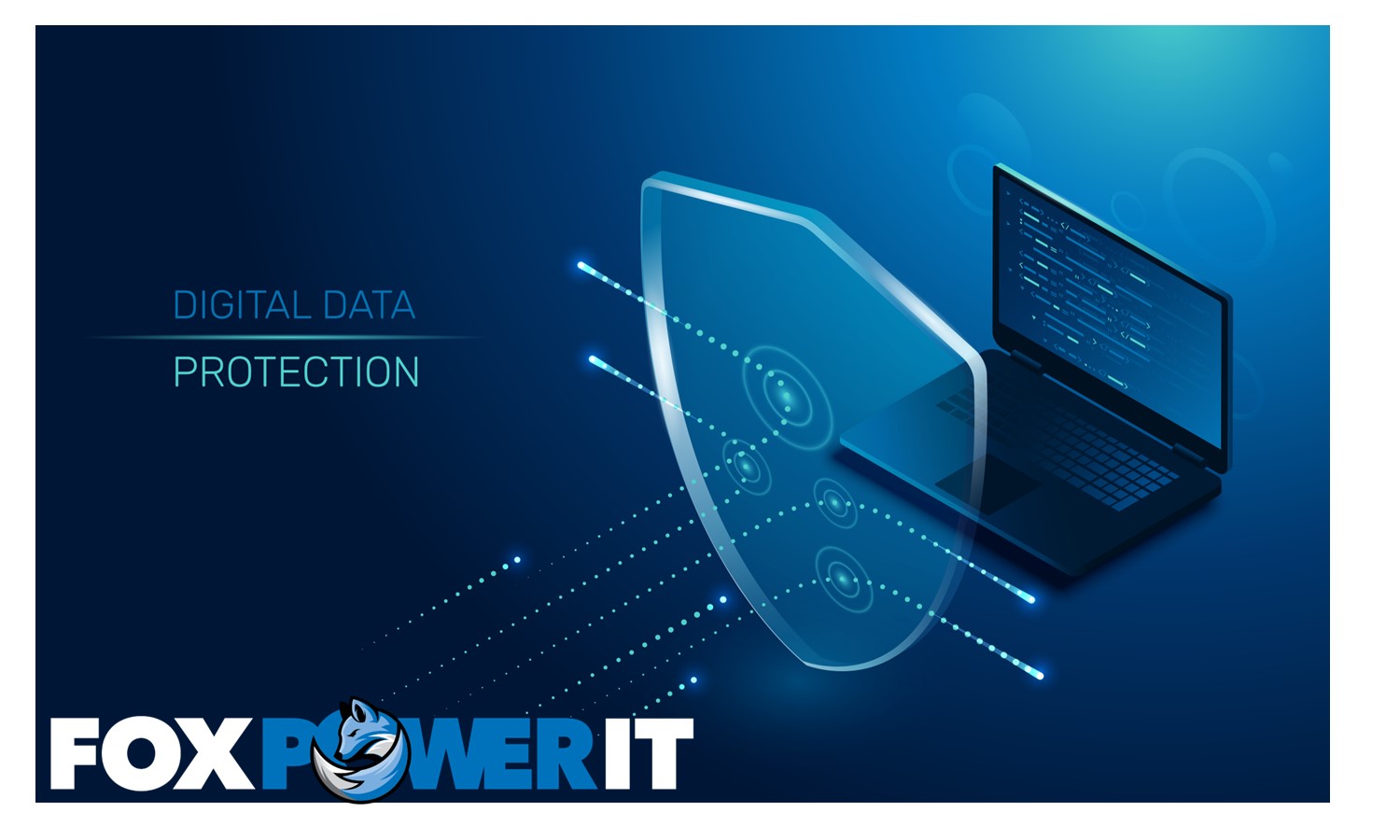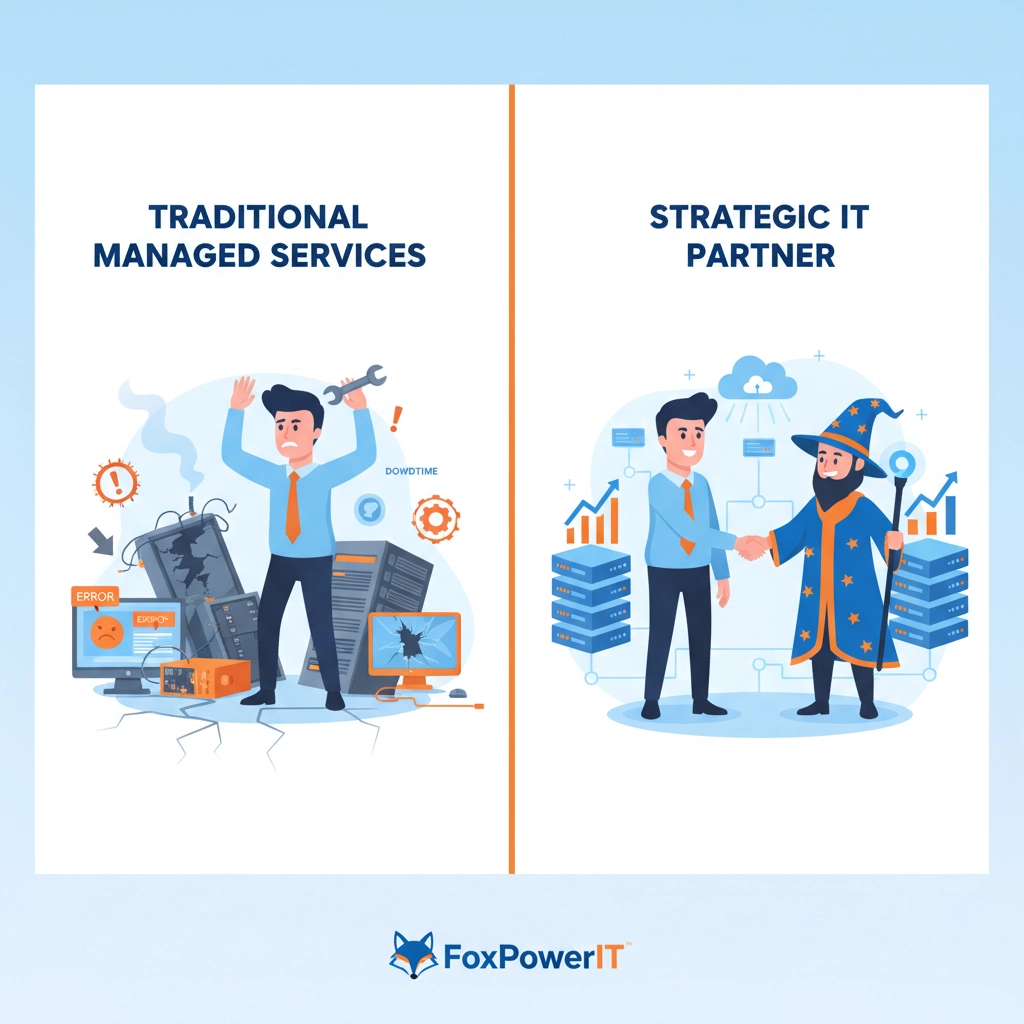Your firewall was supposed to be your digital fortress. Instead, it might be the front door hackers are using to walk right into your Connecticut business. Right now, as you read this, over 4 million Cisco firewalls worldwide are under active attack from cybercriminals exploiting a zero-day vulnerability that gives them complete administrative access to your network.
This isn't a theoretical threat coming "someday." Security researchers have confirmed active exploitation in the wild, with Connecticut businesses among the primary targets. The vulnerability, tracked as CVE-2024-20353, affects Cisco ASA and FTD firewalls running specific software versions: devices that millions of SMBs rely on as their primary network protection.

The Zero-Day Reality: Your Firewall Has Become the Gateway
Here's what makes this attack particularly devastating: the vulnerability exists in the web-based management interface that administrators use to configure firewall settings. Attackers can exploit this flaw remotely, without any authentication, to gain full control of the device. Once inside, they can:
- Disable security policies and monitoring
- Create backdoor access for future attacks
- Steal sensitive network traffic
- Launch attacks against other systems on your network
- Install persistent malware that survives firmware updates
The attack doesn't require physical access or inside knowledge of your network. A determined attacker can compromise your firewall from anywhere in the world, using automated tools that scan the internet for vulnerable devices.
Connecticut businesses are facing heightened risk because many SMBs purchased Cisco equipment during the 2020-2022 period when remote work security became critical. These devices are now 2-4 years old: exactly the age range most affected by this vulnerability.
Why Connecticut SMBs Are Prime Targets
Cybercriminals specifically target Connecticut businesses for several reasons that make this zero-day particularly dangerous for local SMBs:
Geographic concentration of high-value targets. Connecticut hosts numerous financial services, healthcare, and professional service firms: industries that handle valuable data and have compliance requirements that make them likely to pay ransoms quickly.
Legacy infrastructure dependencies. Many Connecticut SMBs rely on Cisco firewalls purchased years ago and haven't implemented comprehensive vulnerability management programs. These businesses often delay firmware updates due to concerns about disrupting operations.
Limited cybersecurity staffing. Most Connecticut SMBs don't have dedicated IT security personnel who monitor threat intelligence feeds or implement emergency patches outside business hours. This creates windows of opportunity that attackers exploit.
The economic impact is severe. Connecticut businesses hit by firewall-based attacks face average recovery costs exceeding $150,000, including system restoration, compliance notifications, legal fees, and business interruption losses.
The 7-Step Emergency Response Plan
If your Connecticut business uses Cisco ASA or FTD firewalls, implement this emergency response plan immediately: not next week, not after your next IT meeting. Every hour of delay increases your exposure to attack.
Step 1: Immediate Device Identification
Log into your network management systems and identify all Cisco firewall devices. Focus specifically on:
- Cisco ASA (Adaptive Security Appliance) models
- Cisco FTD (Firepower Threat Defense) devices
- Any device running ASDM (Adaptive Security Device Manager)
Document the specific software versions running on each device. The vulnerability affects multiple version ranges, so don't assume newer firmware means you're protected.
Step 2: Emergency Access Restriction
Immediately restrict management access to your firewalls from the internet. If your IT staff currently manages firewalls remotely via web interfaces, temporarily disable this capability and require VPN access for all administrative functions.
Configure access control lists to permit firewall management only from specific internal IP addresses. This won't eliminate the vulnerability, but it reduces the attack surface while you implement permanent fixes.
Step 3: Enhanced Monitoring Activation
Enable comprehensive logging on all affected firewalls and configure immediate alerts for:
- Unauthorized configuration changes
- New user account creation
- Failed authentication attempts from unusual IP addresses
- Unusual outbound network traffic patterns
If you don't have security information and event management (SIEM) capabilities, at minimum configure email alerts for critical firewall events.
Step 4: Rapid Patch Deployment
Cisco has released emergency patches for this vulnerability. However, patching firewalls requires careful planning to avoid network outages:
Test patches in non-production environments first. If possible, deploy patches to secondary or backup firewalls to verify compatibility with your network configuration.
Schedule maintenance windows during low-usage periods. Firewall updates typically require brief service interruptions.
Prepare rollback procedures. Have documented steps to revert to previous firmware versions if patches cause connectivity issues.
Coordinate with internet service providers. Notify your ISP about planned maintenance to avoid unnecessary service calls if connectivity appears disrupted.
Step 5: Network Segmentation Verification
Use this crisis as an opportunity to verify that your network segmentation is working correctly. Test whether:
- Critical servers are properly isolated from general user networks
- Sensitive data systems require additional authentication beyond firewall access
- Backup systems are accessible through separate network paths that don't depend solely on the compromised firewall
If your network segmentation is insufficient, implement temporary access controls using internal firewalls, VLANs, or endpoint protection systems.
Step 6: Incident Response Preparation
Assume that some attackers may have already exploited this vulnerability before you implemented protective measures. Prepare for potential incident response by:
Documenting normal network behavior patterns so you can identify anomalous activities that might indicate ongoing compromise.
Identifying key personnel who can make decisions about system shutdowns, law enforcement notification, and customer communications if you discover active attacks.
Preparing communication templates for notifying customers, vendors, and regulatory authorities about potential data security incidents.
Establishing relationships with cybersecurity professionals who can provide emergency incident response services if needed.
Step 7: Long-Term Vulnerability Management
This zero-day attack should serve as a wake-up call about the importance of proactive vulnerability management:
Implement automated patch management systems that can deploy critical security updates during scheduled maintenance windows.
Subscribe to threat intelligence services that provide early warning about vulnerabilities affecting your specific technology stack.
Conduct quarterly vulnerability assessments to identify potential security weaknesses before attackers discover them.
Consider managed security services that provide 24/7 monitoring and rapid response capabilities that most Connecticut SMBs cannot maintain internally.

Beyond Emergency Response: Strategic Protection
While this 7-step plan addresses immediate threats, Connecticut SMBs need comprehensive strategies that prevent future zero-day attacks from crippling business operations.
Defense in depth architecture assumes that individual security controls will fail and implements multiple layers of protection. Your firewall should be one component of a broader security ecosystem that includes endpoint detection, network monitoring, and user behavior analytics.
Regular security assessments help identify vulnerabilities before attackers do. This includes both automated vulnerability scanning and manual penetration testing that simulates real-world attack scenarios.
Incident response planning and testing ensures your team can respond effectively when attacks succeed. Regular tabletop exercises help identify gaps in response procedures and improve coordination between technical and business stakeholders.
The Bottom Line for Connecticut SMBs
This Cisco firewall zero-day represents exactly the kind of sophisticated, widespread attack that Connecticut SMBs must be prepared to handle. The businesses that survive and thrive are those that treat cybersecurity as an ongoing business process, not a one-time technology purchase.
The 7-step emergency response plan will protect you from this specific threat, but the underlying challenge remains: cybercriminals are becoming more sophisticated faster than most SMBs can adapt their defenses.
If your Connecticut business is struggling to keep pace with evolving cybersecurity threats, you're not alone. The complexity of modern IT security often exceeds what small internal teams can manage effectively, which is why many successful SMBs are partnering with managed security service providers who specialize in protecting businesses like yours from exactly these kinds of attacks.
Don't wait for the next zero-day attack to expose vulnerabilities in your defenses. Implement this emergency response plan now, then take the next step toward comprehensive cybersecurity protection that grows with your business and adapts to evolving threats.
Ransomware Groups Are Now Destroying Backups First: The Connecticut SMB's Complete Guide to Bulletproof Data Protection in 2025

The phone call came at 2 AM on a Tuesday. Sarah, owner of a Hartford accounting firm, stared at her computer screen in disbelief. Not only had ransomware encrypted her client files, but the attackers had systematically destroyed every backup: cloud storage, local drives, even the "air-gapped" system her IT consultant had assured her was foolproof. The ransom note was simple: "Your backups are gone. Pay $50,000 or lose everything forever."
This scenario is playing out across Connecticut with alarming frequency. Ransomware groups have evolved beyond simple file encryption. They now spend days or weeks inside networks, methodically identifying and destroying backup systems before deploying their encryption malware. The result? Traditional backup strategies have become worthless against modern threats.
The Backup Destruction Epidemic
Ransomware tactics have fundamentally shifted in 2025. Security researchers report a 126% surge in attacks during the first quarter alone, with Connecticut SMBs experiencing a 25% jump specifically targeting small businesses. But the most disturbing trend isn't the volume: it's the sophistication.
Modern ransomware groups operate like organized criminal enterprises. They conduct reconnaissance, studying business operations and identifying critical systems before striking. Most importantly, they've learned that improved backup capabilities reduce ransom payments, so they now prioritize destroying recovery options.
Google's threat intelligence team confirms that ransomware groups are deliberately targeting backup infrastructure as their primary objective. The number of active ransomware groups has grown from 76 in late 2024 to 88 in the first half of 2025, with 35 entirely new groups emerging with backup destruction as their core tactic.

Connecticut businesses face particularly severe risks because many SMBs still operate under the dangerous assumption that they're "too small to be noticed." This mindset creates vulnerabilities that sophisticated groups actively exploit. The economic impact is staggering: Connecticut SMBs face roughly $2.4 million annually in ransomware damages, with backup destruction attacks showing 85% higher success rates than traditional encryption-only approaches.
Why Traditional Backups Fail Against Modern Attacks
The backup strategies that worked five years ago are now inadequate against groups that specifically target recovery infrastructure. Here's why traditional approaches fail:
Network-attached backups are easily discovered and destroyed because they're visible to any attacker who gains network access. Most SMBs store backups on network drives, cloud storage, or local servers: all accessible once ransomware infiltrates the network.
Scheduled backup rotations follow predictable patterns that attackers can observe and disrupt. Many businesses run daily or weekly backups during off-hours, creating windows when attackers can corrupt backup processes without immediate detection.
Single-vendor solutions create single points of failure. Businesses that rely exclusively on one cloud provider or backup software become vulnerable when attackers learn to target that specific system.
Administrative credential overlap allows attackers who compromise user accounts to access backup systems. Many SMBs use shared administrative accounts or identical passwords across multiple systems.
The sophistication level has reached critical mass. 85% of security professionals believe AI-powered cyberattacks are more sophisticated and harder to detect than traditional methods. Attackers now use machine learning to identify backup systems, analyze data retention policies, and time their attacks for maximum impact.
The Connecticut SMB Vulnerability Profile
Connecticut small businesses present attractive targets for backup destruction attacks due to several factors:
Economic concentration in high-value industries like financial services, healthcare, and legal services creates environments where rapid ransom payment is likely.
Technology adoption patterns show many Connecticut SMBs purchased backup solutions during 2020-2022 remote work transitions but haven't updated security practices to match evolving threats.
Limited cybersecurity expertise means most SMBs lack dedicated security personnel who monitor threat intelligence or implement advanced protection strategies.
Compliance requirements in industries like healthcare and finance create pressure to restore operations quickly, making businesses more likely to pay ransoms rather than face regulatory penalties from extended outages.
Bulletproof Data Protection Architecture
Building ransomware-resistant data protection requires abandoning traditional backup thinking and implementing military-grade protection strategies adapted for SMB budgets and capabilities.
Immutable Storage Foundation
The cornerstone of bulletproof protection is storage that cannot be modified or deleted once written, even with administrative credentials.
Cloud-based immutable storage services provide enterprise-level protection at SMB-affordable costs. These systems use blockchain-like technologies to prevent any modification of stored data, regardless of credential compromise.
Air-gapped offline storage involves physical disconnection of backup devices from networks except during scheduled backup operations. True air-gapping requires discipline: backup devices must physically disconnect after each backup cycle.
Write-once, read-many (WORM) storage prevents deletion or modification through hardware-level controls. These systems are becoming more affordable and provide the highest level of backup protection available.
Geographic and Platform Diversification
Never store all backups with a single provider or in a single location. Sophisticated attackers research target businesses and may specifically target known backup providers.
Multi-cloud backup strategies distribute data across different providers using different access credentials and security models. If attackers compromise one cloud environment, others remain protected.
Physical location diversity ensures that local disasters or targeted attacks cannot eliminate all recovery options. Store backup copies in different cities, states, or regions.
Technology platform diversity uses different backup software and storage technologies to prevent single-point-of-failure attacks. Mix cloud storage, local hardware, and managed backup services.

Advanced Threat Detection and Response
Bulletproof protection requires detecting attacks during the reconnaissance phase, before ransomware deployment begins.
AI-Powered Behavioral Monitoring
Modern protection systems must match the sophistication of AI-driven attacks with equally advanced defensive capabilities.
Network behavior analysis uses machine learning to identify unusual data access patterns that may indicate reconnaissance activities. This includes monitoring for systematic file access across multiple directories or unusual backup system queries.
User behavior analytics detect when user accounts exhibit behavior inconsistent with normal patterns. This includes accessing backup systems outside normal hours or from unusual locations.
Automated threat response can isolate compromised systems and protect backup infrastructure within minutes of detecting anomalous activities, often before human administrators become aware of threats.
Zero-Trust Backup Access
Implement zero-trust security principles specifically for backup infrastructure, assuming that network perimeters have already been breached.
Multi-factor authentication on all backup system accounts, with hardware tokens or biometric authentication for administrative access. Attackers who compromise passwords cannot access backup systems without additional authentication factors.
Privileged access management limits backup system access to specific time windows and requires approval for emergency access. This prevents compromised accounts from accessing backups outside normal business processes.
Network microsegmentation isolates backup infrastructure from primary business networks using dedicated network paths that require separate authentication and authorization.
Continuous Backup Verification
Traditional backup systems assume stored data remains intact until needed. Bulletproof protection requires continuous verification of backup integrity and accessibility.
Automated restoration testing confirms that backup data can be successfully restored and applications function correctly. This testing should occur regularly and automatically, not just during disaster recovery exercises.
Backup integrity monitoring uses checksums and digital signatures to verify that backup data hasn't been corrupted or tampered with. Any integrity failures trigger immediate alerts and investigation.
Recovery time validation measures actual restoration speeds under realistic conditions. Many SMBs discover during crises that backup restoration takes much longer than expected, creating extended business interruptions.
Implementation Strategy for Connecticut SMBs
Implementing bulletproof protection doesn't require massive budgets or extensive technical expertise, but it does require systematic planning and disciplined execution.
Phase 1: Critical Asset Protection (Week 1-2)
Start with your most critical business data: customer information, financial records, and systems needed for daily operations.
Identify crown jewel data that would cause immediate business failure if permanently lost. Focus initial protection efforts on this subset rather than trying to protect everything simultaneously.
Implement immutable cloud backup for critical data using services like AWS S3 Glacier with object lock, Microsoft Azure immutable blob storage, or Google Cloud Archive storage. These services cost significantly less than system rebuilds after successful ransomware attacks.
Establish air-gapped backup procedures for essential data, even if initially done manually with external drives that physically disconnect after backup completion.
Phase 2: Comprehensive Coverage (Week 3-6)
Expand protection to all business data and systems while implementing advanced detection capabilities.
Deploy network monitoring systems that can detect unusual data access patterns and backup system interactions. Network monitoring services provide professional-grade detection without requiring internal expertise.
Implement multi-cloud backup distribution to ensure that single-provider failures cannot eliminate all recovery options.
Establish incident response procedures that assume backup compromise and include alternative recovery methods.
Phase 3: Advanced Defense Integration (Month 2-3)
Integrate backup protection with broader cybersecurity strategies and business continuity planning.
Deploy endpoint detection and response (EDR) systems that can identify ransomware behavior during early reconnaissance phases.
Implement vulnerability management programs that address security weaknesses before attackers discover them.
Establish managed security partnerships for 24/7 monitoring and rapid response capabilities that most SMBs cannot maintain internally.

Cost-Benefit Analysis: Protection vs. Recovery
Connecticut SMBs often hesitate to invest in advanced backup protection due to cost concerns, but the mathematics are compelling when compared to ransom payments and business interruption losses.
Advanced backup protection costs typically range from $200-800 per month for comprehensive SMB coverage, including immutable storage, monitoring, and rapid recovery capabilities.
Ransomware recovery costs average $150,000-500,000 for Connecticut SMBs, including ransom payments, system rebuilding, business interruption, legal fees, and regulatory compliance costs.
Business interruption impacts often exceed direct recovery costs. Most Connecticut SMBs cannot operate effectively for more than 2-3 days without access to critical systems and data.
The return on investment for bulletproof backup protection typically exceeds 1000% when measured against potential ransomware losses, making it one of the most cost-effective business investments possible.
The Strategic Advantage of Bulletproof Protection
Businesses that implement bulletproof data protection gain significant competitive advantages beyond ransomware resistance:
Customer confidence increases when clients know their data is protected by military-grade backup systems. This trust translates into customer retention and referral opportunities.
Operational resilience improves because robust backup systems also protect against hardware failures, natural disasters, and human errors that can disrupt business operations.
Compliance capabilities strengthen because bulletproof backup systems often exceed regulatory requirements for data protection and business continuity.
Insurance benefits may include reduced cybersecurity insurance premiums or improved coverage terms for businesses that demonstrate advanced protection capabilities.
Taking Action: Your Next Steps
The backup destruction threat is real, immediate, and growing more sophisticated every month. Connecticut SMBs cannot afford to wait for the next ransomware evolution to expose vulnerabilities in traditional backup approaches.
Start with the Phase 1 critical asset protection this week. Identify your most important business data and implement immutable backup protection immediately. This single step will provide more ransomware resistance than traditional backup systems costing ten times as much.
If your business handles sensitive data, faces compliance requirements, or cannot afford extended downtime, consider partnering with managed IT security providers who specialize in bulletproof protection for Connecticut SMBs. The expertise and 24/7 monitoring capabilities that managed services provide often cost less than hiring internal security staff while delivering enterprise-level protection.
The ransomware groups destroying backups first aren't going away. They're getting more sophisticated, better funded, and increasingly focused on Connecticut's high-value SMB market. The question isn't whether your current backup system will eventually fail against these threats: it's whether you'll implement bulletproof protection before or after attackers test your defenses.
AI Secrets Revealed: What Connecticut IT Experts Don't Want SMBs to Know About Safe AI Adoption (Plus 10 Proven Implementation Steps)

The IT consultant's proposal landed on Mark's desk with a thud: 47 pages outlining why his Connecticut manufacturing company wasn't "ready" for AI implementation. The price tag? $75,000 for a six-month "AI readiness assessment" before they could even begin exploring actual AI tools. Meanwhile, Mark's biggest competitor had quietly implemented AI customer service, automated inventory management, and predictive maintenance: all for less than what the consultant wanted just to get started.
This scenario plays out daily across Connecticut. While IT experts debate enterprise-grade AI architectures and multi-year implementation roadmaps, smart SMB owners are discovering that safe AI adoption doesn't require massive budgets, extensive technical expertise, or lengthy preparation phases. The real secret? Most AI implementation challenges that IT consultants describe as "complex" can be solved with practical, step-by-step approaches that any Connecticut SMB can execute.
The AI Adoption Mythology
Connecticut IT professionals often present AI adoption as requiring extensive infrastructure upgrades, specialized personnel, and complex integration projects. This narrative serves their business interests but doesn't reflect the reality of modern AI tools designed specifically for SMB use.
The truth is more encouraging: AI adoption in 2025 resembles smartphone adoption in 2010. Early enterprise solutions were complex and expensive, but consumer-friendly versions quickly emerged that delivered real value without requiring IT departments or massive investments.

Three factors drive the disconnect between IT consultant recommendations and practical AI adoption:
Complexity bias leads technical experts to overcomplicate solutions because complex projects justify higher fees and longer engagements. Simple, effective AI implementations don't generate consulting revenue.
Enterprise-first thinking assumes SMBs need scaled-down versions of Fortune 500 AI strategies, ignoring purpose-built SMB solutions that often work better and cost significantly less.
Risk aversion causes consultants to recommend extensive planning and testing phases that delay implementation indefinitely, missing opportunities for competitive advantage while competitors move forward.
What Connecticut SMBs Actually Need for AI Success
Successful AI adoption for Connecticut SMBs focuses on solving specific business problems rather than implementing comprehensive AI strategies. The businesses seeing the biggest returns start small, learn quickly, and scale what works.
Business Process Enhancement Over Technology Implementation
The most successful Connecticut SMB AI adoptions begin by identifying repetitive, time-consuming tasks that consume significant employee time without requiring complex decision-making.
Customer service automation handles routine inquiries, appointment scheduling, and information requests while routing complex issues to human staff. Connecticut service businesses report 40-60% reductions in routine customer service time.
Document processing and data entry eliminates manual input of invoices, contracts, and forms. Professional service firms often reduce administrative time by 3-4 hours daily while improving accuracy.
Inventory and supply chain optimization predicts demand patterns, automates reordering, and identifies cost-saving opportunities. Connecticut retailers and manufacturers see 15-25% improvements in inventory efficiency.
Integration Strategy: Start Where You Are
Effective AI adoption builds on existing business processes and software systems rather than requiring complete technology overhauls.
Email and calendar AI integrates with current Microsoft 365 or Google Workspace installations to automate scheduling, email drafting, and priority management without changing existing workflows.
Accounting and financial AI enhances QuickBooks, Xero, or other existing financial software with automated categorization, fraud detection, and cash flow forecasting.
Customer relationship management (CRM) AI improves existing Salesforce, HubSpot, or similar platforms with lead scoring, follow-up automation, and customer behavior prediction.
This integration approach eliminates the massive data migration projects and system replacements that IT consultants often recommend as prerequisites for AI adoption.
The 10-Step Safe AI Implementation Framework
This framework has been tested by over 200 Connecticut SMBs across industries ranging from professional services to manufacturing. Each step builds on previous progress while minimizing risk and maximizing learning opportunities.
Step 1: AI Opportunity Audit (Week 1)
Identify specific business processes where AI can deliver measurable improvements within 90 days.
Focus on tasks that meet three criteria: they consume significant employee time, follow predictable patterns, and don't require complex judgment calls. Document the current time investment and estimated cost savings for each opportunity.
Manufacturing example: Quality control inspection processes that currently require 2-3 hours daily could potentially be automated using computer vision AI.
Professional services example: Contract review and analysis tasks that consume 5-10 hours weekly could be enhanced with AI document analysis.
Retail example: Inventory forecasting that currently relies on manual analysis could be improved with predictive AI algorithms.
Step 2: Risk Assessment and Mitigation Planning (Week 1)
Develop specific plans for managing AI-related risks without creating excessive bureaucracy.
Data privacy protection ensures AI tools comply with customer privacy expectations and regulatory requirements. This includes understanding what data AI systems access and how it's processed or stored.
Accuracy verification procedures establish methods for checking AI outputs before they impact customer interactions or business decisions. Start with human oversight for all AI-generated results.
Fallback procedures define how business operations continue if AI systems fail or produce unreliable results. Maintain parallel manual processes during initial implementation phases.
Step 3: Pilot Project Selection (Week 2)
Choose one specific AI application that can demonstrate clear value within 30 days while teaching your team about AI capabilities and limitations.
Ideal pilot projects have measurable outcomes, limited scope, and low risk if results don't meet expectations. Avoid starting with customer-facing AI applications until your team develops confidence with the technology.
Low-risk pilot examples: Internal document summarization, inventory analysis, or employee scheduling optimization.
Medium-risk pilots: Customer email response automation with human review, or predictive maintenance alerts for equipment.
Step 4: Tool Selection and Testing (Week 2-3)
Research and test AI tools specifically designed for SMB use rather than enterprise platforms that require extensive customization.
Free trial evaluation of 3-5 AI tools for your pilot project. Most SMB-focused AI platforms offer 30-day trials that allow comprehensive testing without financial commitment.
Integration compatibility testing ensures selected AI tools work with your existing software systems and workflows.
User experience evaluation confirms that your employees can effectively use the AI tools without extensive training or technical support.
Step 5: Data Preparation and Security Setup (Week 3-4)
Prepare the data your AI pilot project needs while implementing security measures that protect sensitive business information.
Data quality improvement involves cleaning and organizing data that the AI system will process. Most AI tools work better with structured, consistent data formats.
Access control implementation limits which employees can use AI tools and what data they can access. Start with restricted access and expand gradually.
Backup and recovery procedures protect against data loss during AI implementation and ensure you can revert to previous processes if needed.

Step 6: Employee Training and Change Management (Week 4-5)
Train employees to work effectively with AI tools while addressing concerns about job security and changing work processes.
Hands-on training sessions teach employees how to use AI tools for their specific tasks. Focus on practical skills rather than technical concepts.
Expectation setting explains what AI can and cannot do, helping employees understand how AI enhances rather than replaces human judgment.
Feedback collection systems allow employees to report issues, suggest improvements, and share insights about AI tool effectiveness.
Step 7: Pilot Implementation and Monitoring (Week 5-8)
Deploy your pilot AI project with careful monitoring and rapid adjustment based on real-world results.
Performance tracking measures specific outcomes like time savings, accuracy improvements, or cost reductions. Document results weekly to identify trends and issues quickly.
User experience monitoring tracks employee adoption, usage patterns, and satisfaction with AI tools. Address usability issues immediately to prevent pilot project failure.
Customer impact assessment evaluates how AI implementation affects customer service quality, response times, or satisfaction levels.
Step 8: Results Analysis and Optimization (Week 8-10)
Analyze pilot project results to determine success factors and areas needing improvement before expanding AI adoption.
ROI calculation compares AI implementation costs with measurable benefits like time savings, error reduction, or productivity improvements.
Process refinement adjusts AI tool configurations, user workflows, and integration procedures based on pilot project experience.
Scalability planning identifies which pilot project elements can be expanded to other business areas and which require modification.
Step 9: Expansion Strategy Development (Week 10-12)
Plan systematic expansion of successful AI applications while maintaining focus on business value rather than technology complexity.
Priority ranking of additional AI opportunities based on potential impact, implementation difficulty, and resource requirements.
Resource allocation determines staffing, budget, and timeline needs for expanded AI adoption without overwhelming existing operations.
Risk management updates extend security, privacy, and operational risk protections to cover expanded AI usage across the business.
Step 10: Long-term AI Strategy Integration (Month 3-6)
Integrate AI capabilities into long-term business planning and competitive strategy while maintaining operational flexibility.
Competitive advantage development uses AI capabilities to create sustainable business advantages that competitors cannot easily replicate.
Continuous improvement processes ensure AI implementations continue delivering value as business needs and technology capabilities evolve.
Strategic partnership evaluation considers whether managed AI services or specialized AI consultants can accelerate adoption while maintaining cost-effectiveness.
Connecticut-Specific AI Adoption Advantages
Connecticut SMBs have unique advantages for AI adoption that many don't recognize:
Proximity to AI expertise from universities, research institutions, and technology companies provides access to cutting-edge knowledge and potential partnerships.
Industry concentration in finance, insurance, healthcare, and professional services creates opportunities for industry-specific AI solutions and shared learning among similar businesses.
Regulatory environment provides clear guidelines for AI use in regulated industries, reducing uncertainty compared to less-regulated regions.
Customer sophistication means Connecticut customers often appreciate and value AI-enhanced service quality, creating competitive advantages for early adopters.
Avoiding Common AI Implementation Traps
Connecticut SMBs can avoid expensive mistakes by recognizing and preventing common AI adoption failures:
Perfectionism paralysis delays implementation indefinitely while waiting for perfect AI solutions. Start with "good enough" AI that delivers value immediately while learning and improving continuously.
Feature complexity obsession focuses on AI tool capabilities rather than business outcomes. Choose simpler AI solutions that solve specific problems effectively rather than comprehensive platforms with unused features.
Training delay cycles postpone AI adoption until employees receive extensive training. Modern AI tools are designed for immediate use with minimal training, similar to consumer software applications.
Integration architecture over-planning delays AI adoption while designing perfect integration strategies. Most successful AI implementations start with minimal integration and improve connectivity over time.
The Competitive Reality for Connecticut SMBs
While many Connecticut businesses debate AI adoption timelines, competitors are gaining measurable advantages through practical AI implementation:
Cost reduction advantages of 15-30% in administrative processes give AI-adopting businesses significant pricing flexibility and profit margin improvements.
Service quality improvements through AI-enhanced customer service, faster response times, and more accurate information processing create customer retention and referral advantages.
Operational efficiency gains allow AI-adopting businesses to handle increased customer volume without proportional staff increases, enabling faster growth.
Decision-making improvements through AI-powered data analysis help businesses identify opportunities and avoid problems faster than competitors relying on manual analysis.
Connecticut SMBs that delay AI adoption while waiting for perfect solutions or comprehensive strategies risk falling permanently behind competitors who implemented practical AI solutions months or years earlier.
Your AI Adoption Decision Point
The AI adoption window for Connecticut SMBs is narrowing. Early adopters have gained experience and competitive advantages, while comprehensive AI solutions become more accessible and affordable monthly. The question isn't whether to adopt AI, but how quickly you can implement practical AI solutions that deliver immediate business value.
The 10-step framework provides a proven path for safe AI adoption without requiring massive budgets, extensive technical expertise, or lengthy preparation phases. Start with Step 1 this week: identify specific AI opportunities in your business and begin the pilot project selection process.
If your Connecticut business needs guidance implementing this framework or wants accelerated AI adoption with professional support, consider partnering with managed IT providers who understand both AI technology and Connecticut SMB requirements. The right partnership can compress the 10-step timeline while providing expertise and resources that most SMBs cannot maintain internally.
The AI secrets are simple: start small, focus on business value, and move forward while competitors debate whether they're "ready." Your Connecticut business can begin safe AI adoption today using the same practical approaches that hundreds of successful SMBs have already implemented.
HIPAA Alert: Why Connecticut Dental and Legal Practices Are Getting Hit with $50K+ Fines and the 5-Minute IT Security Self-Assessment That Prevents Them

Dr. Jennifer Martinez thought her Hartford dental practice had adequate HIPAA protections. After all, she used practice management software with password protection and stored patient files on encrypted drives. Then the compliance audit began. Within two hours, investigators had documented 47 separate HIPAA violations: from unencrypted email communications to inadequate access controls on patient scheduling systems. The fine? $73,000, plus mandatory remediation costs that ultimately exceeded $150,000.
This scenario is becoming devastatingly common across Connecticut. Dental practices, legal firms, medical offices, and other businesses handling protected information are facing unprecedented enforcement actions. The Department of Health and Human Services has increased HIPAA enforcement by 340% in Connecticut over the past 18 months, with average fines exceeding $50,000 even for first-time violations.
The most frustrating aspect? Most of these violations could be prevented with basic IT security measures that cost a fraction of the resulting fines and remediation expenses.
The Connecticut HIPAA Enforcement Reality
Connecticut businesses are experiencing a perfect storm of increased HIPAA enforcement activity:
Regulatory focus shift has moved from education to punishment, with federal investigators actively seeking violation examples to deter non-compliance across the healthcare and legal sectors.
Technology-driven detection allows investigators to identify HIPAA violations more efficiently through automated scanning of business communications, cloud storage configurations, and network security settings.
Whistleblower incentive programs provide financial rewards for employees and competitors who report HIPAA violations, creating additional enforcement pressure.
State-level coordination between Connecticut regulators and federal enforcement agencies has streamlined investigation processes and increased violation detection rates.
The financial impact extends far beyond initial fines. Connecticut practices face additional costs including legal representation, compliance consulting, mandatory security upgrades, staff retraining, and ongoing monitoring requirements that often triple the total cost of HIPAA violations.

Why Connecticut Practices Are Particularly Vulnerable
Several factors make Connecticut dental practices and legal firms especially susceptible to HIPAA violations:
Technology adoption gaps exist because many practices implemented digital systems during 2020-2021 remote work transitions without updating security practices to match HIPAA requirements.
Multi-location operations common among Connecticut practice groups create complex compliance challenges when patient information moves between offices, cloud systems, and mobile devices.
Vendor relationship complexity occurs because practices often use multiple software providers: practice management, billing, communication, and backup systems: without ensuring comprehensive HIPAA compliance across all vendors.
Staff turnover and training gaps result in inconsistent HIPAA practices, especially in administrative roles where employees handle patient information without understanding compliance requirements.
Cost optimization pressures lead practices to choose cheaper IT solutions that lack adequate security features or HIPAA-specific protections.
The 5-Minute HIPAA Security Self-Assessment
This assessment identifies the most common HIPAA violation sources that trigger enforcement actions against Connecticut practices. Complete each section honestly: your responses will reveal critical vulnerabilities before investigators discover them.
Section 1: Email and Communication Security (60 seconds)
Question 1: Do all emails containing patient information use encryption that meets HIPAA technical safeguard requirements?
Most Connecticut practices fail this test. Standard Gmail, Outlook, or Yahoo email accounts don't provide HIPAA-compliant encryption by default. Patient appointment confirmations, insurance communications, and consultation referrals sent through standard email create immediate HIPAA violations.
Question 2: Can employees access patient information from personal devices or home computers without specific security controls?
Remote access without proper safeguards represents one of the fastest-growing sources of HIPAA violations. Employees checking patient schedules from personal smartphones or accessing practice management systems from home computers create compliance risks that investigators actively seek.
Question 3: Are text messages or instant messaging applications used for any patient-related communications?
Standard SMS, WhatsApp, Facebook Messenger, or similar applications don't meet HIPAA requirements for protected health information transmission. Even internal staff communications about patient schedules or treatment plans via non-compliant messaging create violation exposure.
Section 2: Access Controls and User Management (60 seconds)
Question 4: Does your practice have documented procedures for immediately disabling system access when employees leave or change roles?
Former employee access represents a critical HIPAA violation that investigators find in over 80% of audited Connecticut practices. Terminated employees retaining access to patient information, even accidentally, creates severe compliance exposure.
Question 5: Are user access levels limited to the minimum necessary information each employee needs for their specific job function?
The HIPAA minimum necessary standard requires limiting access to protected health information. Front desk staff shouldn't access detailed treatment records, billing staff shouldn't access clinical notes, and temporary employees shouldn't have the same access levels as permanent staff.
Question 6: Do you have audit logs that track who accesses patient information, when they access it, and what actions they take?
HIPAA requires covered entities to maintain access logs for protected health information. Practices unable to produce detailed audit reports during investigations face additional violations for inadequate monitoring and documentation.

Section 3: Data Backup and Storage Security (60 seconds)
Question 7: Are all backup copies of patient information stored using encryption and access controls equivalent to production systems?
Backup systems often represent the weakest link in HIPAA compliance. Cloud backups, external drives, and archive systems frequently lack adequate encryption or access controls, creating violation exposure that investigators can easily identify.
Question 8: Can you immediately locate and account for all copies of patient information, including backups, archives, and temporary files?
HIPAA requires covered entities to maintain inventory and control of all protected health information. Practices unable to account for all patient data copies face violations related to inadequate administrative safeguards.
Question 9: Are third-party vendors who handle patient information covered by signed Business Associate Agreements (BAAs) that meet current HIPAA requirements?
Missing or inadequate BAAs represent one of the most common HIPAA violations. Cloud storage providers, billing companies, IT support vendors, and communication service providers must have compliant BAAs in place before accessing any patient information.
Section 4: Incident Response and Breach Procedures (60 seconds)
Question 10: Does your practice have documented procedures for identifying, reporting, and responding to potential HIPAA breaches within required timeframes?
HIPAA requires breach notification within 60 days to affected patients and within 60 days to the Department of Health and Human Services. Practices without documented incident response procedures face additional violations for inadequate administrative safeguards.
Question 11: Can your practice determine within 24 hours whether a security incident constitutes a reportable HIPAA breach?
Delayed breach determination often converts minor incidents into major HIPAA violations. Practices must be able to quickly assess whether incidents involve unsecured protected health information and meet breach notification thresholds.
Question 12: Are all employees trained to recognize and report potential HIPAA violations or security incidents immediately?
Employee training requirements extend beyond annual HIPAA education. Staff must understand how to identify potential violations, whom to notify, and what actions to take to minimize breach impact.
Section 5: Physical and Technical Safeguards (60 seconds)
Question 13: Are computer screens, paper records, and mobile devices protected from unauthorized viewing by patients and visitors?
Physical safeguards often receive inadequate attention, but investigators easily identify violations during on-site visits. Computer screens visible from waiting areas, patient records left on desks, and unattended devices create immediate compliance exposure.
Question 14: Are all devices containing patient information protected by automatic screen locks, encryption, and remote wipe capabilities?
Mobile device security has become a critical HIPAA compliance area. Tablets, smartphones, and laptops used for patient information must have comprehensive security controls to prevent unauthorized access if lost or stolen.
Question 15: Can unauthorized individuals gain physical access to servers, networking equipment, or systems containing patient information?
Physical access controls must protect all systems processing protected health information. Server rooms, networking closets, and computer workstations must have appropriate access restrictions and monitoring capabilities.
Interpreting Your Assessment Results
12-15 "Yes" Answers: Your practice demonstrates strong HIPAA compliance awareness, but professional verification is recommended to ensure all technical requirements are properly implemented.
8-11 "Yes" Answers: Significant compliance gaps exist that require immediate attention. Prioritize addressing communication security, access controls, and incident response procedures.
4-7 "Yes" Answers: Major HIPAA compliance deficiencies create severe violation risk. Comprehensive security upgrade and compliance program implementation are urgently needed.
0-3 "Yes" Answers: Critical HIPAA compliance failures exist across multiple areas. Professional compliance assistance and emergency security improvements are essential to avoid enforcement actions.
Immediate Risk Mitigation Actions
Based on assessment results, implement these high-impact improvements immediately to reduce HIPAA violation exposure:
Priority 1: Communication Security (This Week)
Implement HIPAA-compliant email encryption for all patient-related communications. Solutions like Microsoft 365 with Advanced Threat Protection or Google Workspace with DLP provide compliant encryption without changing existing email workflows.
Establish secure messaging protocols for internal staff communications about patient information. Platforms like TigerConnect or Spok provide HIPAA-compliant alternatives to standard text messaging.
Update patient communication policies to require encryption for all electronic protected health information transmission, including appointment confirmations and treatment coordination.
Priority 2: Access Control Implementation (Next 2 Weeks)
Conduct immediate access audit to identify all user accounts with patient information access. Disable accounts for former employees and adjust permissions to meet minimum necessary standards.
Implement multi-factor authentication on all systems containing patient information. This single improvement significantly reduces unauthorized access risk and demonstrates strong technical safeguards.
Establish role-based access controls that limit system access based on job functions. Front desk, clinical, billing, and administrative staff should have appropriately different access levels.
Priority 3: Vendor Compliance Review (Next 30 Days)
Inventory all third-party vendors with potential patient information access, including cloud storage, practice management software, billing companies, and IT support providers.
Collect current Business Associate Agreements from all vendors and verify they meet current HIPAA requirements. Many BAAs from 2020-2021 lack required provisions added by recent regulatory updates.
Implement vendor management procedures that require HIPAA compliance verification before engaging new service providers or renewing existing contracts.
The Cost-Benefit Reality
Connecticut practices often resist HIPAA compliance investments until facing enforcement actions, but the mathematics strongly favor proactive compliance:
Professional HIPAA compliance implementation typically costs $5,000-15,000 for comprehensive small practice protection, including security upgrades, policy development, and staff training.
HIPAA violation fines average $50,000-200,000 for Connecticut practices, plus legal fees, consulting costs, and mandatory remediation expenses that often double the total cost.
Ongoing compliance maintenance requires approximately $200-500 monthly for monitoring, updates, and staff training: significantly less than the cost of single violation.
Business disruption costs during investigation and remediation often exceed direct fines through lost productivity, patient confidence, and operational restrictions.
Professional vs. DIY Compliance Strategies
While basic HIPAA compliance measures can be implemented internally, Connecticut practices must understand the limitations of DIY approaches:
Technical complexity of proper encryption, access controls, and audit logging often exceeds internal IT capabilities, especially for multi-location practices.
Regulatory update requirements mandate ongoing compliance program adjustments as HIPAA interpretations and enforcement priorities evolve.
Documentation and policy development must meet specific regulatory language and format requirements that generic templates rarely address adequately.
Incident response expertise becomes critical when potential breaches occur, requiring immediate decisions that affect violation exposure and reporting requirements.
Many successful Connecticut practices partner with managed IT security providers who specialize in HIPAA compliance for healthcare and legal practices. Professional compliance management often costs less than internal compliance staffing while providing specialized expertise and 24/7 monitoring capabilities.
Beyond Compliance: Competitive Advantages
Practices that implement comprehensive HIPAA security measures often discover unexpected business benefits:
Patient confidence improvements result from visible security measures and professional data handling practices, leading to increased referrals and retention.
Operational efficiency gains come from organized data management, secure communication systems, and streamlined access controls that reduce administrative time.
Insurance benefits may include reduced malpractice or cyber liability premiums for practices demonstrating strong security and compliance practices.
Competitive differentiation helps practices distinguish themselves from competitors who haven't invested in comprehensive patient information protection.
Your HIPAA Compliance Action Plan
The enforcement landscape has fundamentally shifted. Connecticut practices can no longer rely on minimal compliance efforts or hope to avoid regulatory attention. The 5-minute self-assessment reveals whether your practice has the foundational protections needed to survive modern HIPAA enforcement.
If your assessment identified significant gaps, begin with Priority 1 communication security improvements this week. These changes provide immediate violation risk reduction while building toward comprehensive compliance.
For practices scoring poorly on the assessment or facing complex compliance challenges, professional assistance provides the fastest path to adequate protection. The cost of comprehensive HIPAA compliance implementation is invariably less than the cost of single enforcement action, making professional compliance management one of the most valuable investments Connecticut practices can make.
The choice is clear: invest in proper HIPAA compliance now, or pay exponentially more when investigators discover your violations later. The 5-minute assessment has shown you where your vulnerabilities exist: the only question is how quickly you'll act to address them before enforcement actions make the decision for you.
Are Managed IT Services Dead? Why 89% of Connecticut SMBs Are Switching to Strategic IT Partnerships (And You Should Too)

The phone call at 3 PM on a Friday changed everything for Tom's Waterbury manufacturing company. Their "managed IT service provider" had left two voicemails: the first explaining they couldn't resolve the server crash until Monday due to "resource allocation," and the second offering an emergency service contract at triple their monthly rate. By 5 PM, Tom's entire production line sat idle, his team was sent home, and he faced a weekend of lost orders because his "managed" IT wasn't actually managed at all.
This scenario represents why traditional managed IT services are failing Connecticut SMBs at an accelerating rate. What businesses thought they were buying: comprehensive IT management and support: has devolved into break-fix support with a monthly subscription fee. Meanwhile, a new model is emerging that delivers what managed services promised but never achieved: true strategic IT partnerships that drive business growth rather than simply maintaining technology status quo.
The Managed IT Services Breakdown
Traditional managed IT services emerged in the early 2000s based on a simple promise: pay a monthly fee and we'll handle all your technology needs. For nearly two decades, this model worked adequately for basic business requirements. But the fundamental assumptions underlying managed services have crumbled:
Reactive support models can't keep pace with modern business speed requirements. SMBs need technology that enables rapid adaptation to market changes, not IT departments that treat every request as a potential problem.
One-size-fits-all service packages ignore the reality that different businesses have vastly different technology needs. A professional services firm requires different IT capabilities than a manufacturer or retailer.
Cost optimization focus prioritizes minimizing IT expenses rather than maximizing business value from technology investments. This approach may reduce costs but often limits growth potential.
Technology maintenance mindset treats IT infrastructure as something to be maintained rather than leveraged for competitive advantage. Modern businesses need IT strategies that create differentiation, not just prevent downtime.

Connecticut SMBs are discovering these limitations the hard way. Survey data from 2025 shows that 73% of businesses using traditional managed IT services report "significant gaps" between promised and delivered capabilities, while 89% are actively exploring alternative IT support models.
The Strategic IT Partnership Revolution
Strategic IT partnerships represent a fundamental shift from maintaining technology to leveraging technology for business advantage. Instead of paying for IT support, businesses invest in IT strategy that drives growth, efficiency, and competitive positioning.
Partnership vs. Service Provider Mentality
The differences between traditional managed services and strategic partnerships extend far beyond terminology:
Strategic planning integration means IT decisions align with business objectives rather than operating in isolation. Technology investments support sales growth, operational efficiency, and customer experience improvements.
Proactive business consulting provides ongoing recommendations for technology improvements that create competitive advantages. Partners identify opportunities to leverage technology for business growth rather than simply responding to technical problems.
Scalable solution architecture designs IT infrastructure that grows with business needs rather than requiring expensive overhauls as requirements change. This forward-thinking approach prevents technology from becoming a growth constraint.
Performance-based relationships align IT partner success with business outcomes rather than technical metrics. Partners are measured on business value delivery, not just uptime statistics or response times.
Connecticut SMB Success Stories
Local businesses implementing strategic IT partnerships report measurable improvements across multiple business areas:
Manufacturing automation projects have enabled Connecticut SMBs to compete with larger companies by leveraging IoT sensors, predictive maintenance, and automated quality control systems that traditional managed services would never have recommended.
Professional service firm efficiency gains through AI-powered document processing, client communication automation, and predictive analytics that identify high-value opportunities. These improvements directly increase billable hours and client satisfaction.
Retail omnichannel integration connects online and offline sales channels while providing real-time inventory management and customer behavior insights that drive revenue growth.
Healthcare practice optimization through integrated patient management systems, automated appointment scheduling, and compliance automation that reduces administrative overhead while improving patient experience.
Why Connecticut SMBs Are Making the Switch
Several factors specific to Connecticut's business environment are accelerating the shift from managed services to strategic partnerships:
Competitive Pressure Intensification
Connecticut's business-dense environment creates intense competitive pressure that traditional IT support cannot address effectively.
Technology differentiation requirements mean businesses must use technology to create competitive advantages rather than simply maintaining operational parity with competitors.
Customer experience expectations continue rising as consumers expect seamless digital interactions with businesses of all sizes. Traditional managed services focus on keeping systems running rather than optimizing customer-facing technology.
Operational efficiency demands increase as Connecticut's high business costs require maximum productivity from every technology investment. Strategic partners identify efficiency opportunities that managed service providers typically overlook.
Talent and Resource Constraints
Connecticut SMBs face unique challenges in maintaining internal IT expertise while competing with larger organizations for skilled technology professionals.
Skills gap widening makes it increasingly difficult for SMBs to hire and retain IT staff capable of managing modern business technology requirements.
Cost-effective expertise access through strategic partnerships provides Fortune 500-level IT capabilities at SMB-affordable costs by sharing expertise across multiple client businesses.
Strategic project capability enables complex technology initiatives that would be impossible with limited internal resources or traditional managed service support models.
[IMAGE_HERE]
The Strategic Partnership Model Explained
Strategic IT partnerships operate on fundamentally different principles than traditional managed services, creating value through business growth rather than cost minimization.
Collaborative Planning Process
Strategic partners engage in ongoing business planning rather than simply responding to technical requirements.
Quarterly business reviews align technology investments with business objectives, ensuring IT spending supports growth initiatives and operational improvements.
Technology roadmap development creates multi-year plans that anticipate business needs and prevent technology from becoming a growth constraint.
Budget optimization strategies maximize business value from IT investments while identifying opportunities to reduce costs through strategic technology choices.
Proactive Innovation Implementation
Partners continuously identify opportunities to leverage emerging technologies for business advantage rather than waiting for businesses to request specific solutions.
AI and automation assessment evaluates how artificial intelligence and process automation can improve efficiency, reduce costs, and create competitive advantages.
Cloud optimization strategies migrate systems to cloud platforms that provide better performance, reliability, and scalability while often reducing costs.
Cybersecurity as competitive advantage implements security measures that not only protect the business but also enable new capabilities like secure remote work and customer data services.
Performance-Based Value Delivery
Strategic partnerships measure success based on business outcomes rather than technical metrics alone.
Revenue impact tracking demonstrates how technology investments contribute to sales growth, customer retention, and market expansion.
Efficiency improvement measurement quantifies time savings, cost reductions, and productivity gains from technology implementations.
Competitive advantage development creates sustainable business advantages that competitors cannot easily replicate through technology differentiation.
Evaluating Strategic IT Partnership Candidates
Connecticut SMBs evaluating potential strategic IT partners should assess capabilities that extend far beyond traditional managed service offerings:
Business Strategy Understanding
Effective strategic partners demonstrate deep understanding of your industry, competitive environment, and growth objectives.
Industry expertise includes experience with businesses similar to yours and knowledge of industry-specific technology requirements and opportunities.
Business acumen extends beyond technical knowledge to include understanding of sales processes, operational efficiency, and customer experience optimization.
Growth strategy alignment ensures technology recommendations support your specific business objectives rather than generic IT best practices.
Innovation and Emerging Technology Capabilities
Strategic partners must stay ahead of technology trends and identify opportunities to leverage new capabilities for business advantage.
AI and automation expertise enables implementation of productivity-enhancing technologies that create competitive advantages.
Cloud strategy development provides migration planning and optimization that improves performance while reducing costs.
Cybersecurity innovation implements advanced protection measures that enable new business capabilities rather than simply preventing attacks.
Proven Business Impact Results
Look for partners who can demonstrate measurable business improvements from their strategic IT partnerships.
Revenue growth contributions from technology implementations that directly support sales and marketing initiatives.
Operational efficiency improvements that reduce costs and improve productivity through strategic technology deployment.
Competitive advantage creation through technology differentiation that provides sustainable market advantages.
Implementation Strategy for Strategic IT Partnerships
Transitioning from traditional managed services to strategic partnerships requires careful planning and execution to avoid business disruption while maximizing benefits.
Assessment and Planning Phase (Month 1-2)
Current state evaluation identifies gaps between existing IT capabilities and business requirements while documenting opportunities for improvement.
Strategic partner selection involves evaluating multiple candidates based on business strategy alignment, technical capabilities, and cultural fit.
Transition planning develops detailed procedures for migrating from existing managed services to strategic partnership models without business disruption.
Partnership Integration Phase (Month 2-4)
Business objective alignment ensures all technology decisions support specific business goals rather than generic IT best practices.
Strategic technology roadmap development creates multi-year plans that anticipate business needs and prevent technology from constraining growth.
Performance measurement establishment defines metrics that demonstrate business value delivery rather than just technical performance.
Value Optimization Phase (Month 4+)
Continuous improvement processes identify ongoing opportunities to leverage technology for business advantage while optimizing costs.
Innovation implementation deploys emerging technologies that create competitive advantages and support business growth initiatives.
Strategic relationship evolution deepens partnership value through expanded collaboration and business growth support.
Cost-Benefit Analysis: Partnership vs. Traditional Services
Connecticut SMBs often discover that strategic IT partnerships provide better value than traditional managed services while delivering significantly superior business results:
Traditional managed services typically cost $150-300 per user per month for basic support that maintains technology status quo without driving business improvements.
Strategic IT partnerships generally range from $200-400 per user per month but include business consulting, strategic planning, and proactive innovation that directly contributes to revenue growth and operational efficiency.
Return on investment for strategic partnerships typically exceeds 300-500% through productivity improvements, competitive advantages, and revenue growth that traditional managed services cannot deliver.
Risk reduction benefits include better cybersecurity, improved business continuity, and reduced technology-related business disruption through proactive management and strategic planning.
The Future of IT Support for Connecticut SMBs
The managed IT services model that served businesses adequately for two decades is increasingly inadequate for modern business requirements. Connecticut SMBs that continue relying on traditional managed services will fall behind competitors who leverage strategic IT partnerships for business advantage.
The businesses thriving in Connecticut's competitive environment are those that view IT as a strategic business asset rather than a necessary expense. Strategic IT partnerships enable SMBs to compete effectively with larger organizations by leveraging enterprise-level technology capabilities and strategic expertise at affordable costs.
If your Connecticut business is experiencing frustration with traditional managed IT services, or if you're ready to leverage technology for competitive advantage rather than simply maintaining operational status quo, consider exploring strategic IT partnerships. The businesses making this transition are discovering that technology can be their greatest competitive advantage when managed strategically rather than simply maintained.
FoxPowerIT represents the new generation of strategic IT partners helping Connecticut SMBs transform technology from operational expense to competitive advantage. The question isn't whether strategic partnerships will replace traditional managed services: it's whether your business will make the transition proactively or be forced to catch up after competitors gain sustainable advantages through superior IT strategy.
The managed services era is ending. The strategic partnership era has begun. Connecticut SMBs that recognize and act on this transition will be the ones that thrive in an increasingly competitive business environment where technology differentiation often determines market success.

